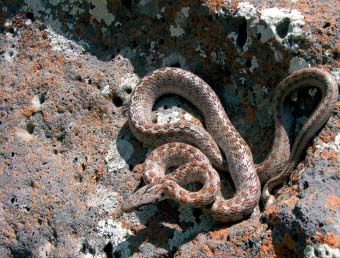Transcaucasian rat snake: Red Data Book of Armenia

Colubrids — Colubridae
Status. Listed in the Red Data Books of the former USSR, Georgia and Azerbaijan. According to IUCN criteria categorized as Vulnerable VU B1ab (iii).
Distribution. Asia Minor, Northwestern Iran, Southern Lebanon, Northern Israel, North Ossetia, Chechnya, Ingushetia, Daghestan, Georgia, Azerbaijan, Armenia.
Distribution in Armenia. Occurs in the country’s northern and southern parts, but mainly in the foothills of the Arax basin.
Habitats. Inhabits stony slopes, cliffs and fractures covered with arid thickets and herbage. In Khosrov Forest Reserve lives in rock crevices and juniper sparse forests. In the Hamberd riparian canyon occurs in sparse oakeries, scrubs, rocky banks and canyon slopes. On the outskirts of Yerevan inhabits open and stony slopes covered by orchards, vineyards, ruins and hedges. Reaches elevations ca. 2200 m above sea level.
Biological traits. Comes outwards after hibernation from early to mid–April. Feeds on murids and lizards, juveniles also eat insects. Eggs are laid in mid–June, 3–7 eggs/clutch. Hatchlings emerge in early September.
Population size and its trends. In spring, in Khosrov Forest 1–2 individuals can be encountered over 6–7 km of 5 hr hiking. Illegal harvesting and deterioration of typical habitats make the population dwindle, especially in the vicinities of Yerevan.
Major threats. Poaching and habitat destruction.
Conservation measures. Protected in Khosrov Forest Reserve, Shikahogh Reserve and Arevik National Park. It is essential to set stringent control over poaching.
Suggestions
 The Ministry of Environment sent a letter international partners to draw their attention to the real danger of environmental disasters as a result of Azerbaijan's large-scale aggression towards the territory of Armenia
The Ministry of Environment sent a letter international partners to draw their attention to the real danger of environmental disasters as a result of Azerbaijan's large-scale aggression towards the territory of Armenia
 Vicia pisiformis: Red Data Book of Armenia
Vicia pisiformis: Red Data Book of Armenia
 Vavilovia formosa: Red Data Book of Armenia
Vavilovia formosa: Red Data Book of Armenia
 Trigonella capitata: Red Data Book of Armenia
Trigonella capitata: Red Data Book of Armenia
 Trigonella astroides: Red Data Book of Armenia
Trigonella astroides: Red Data Book of Armenia












